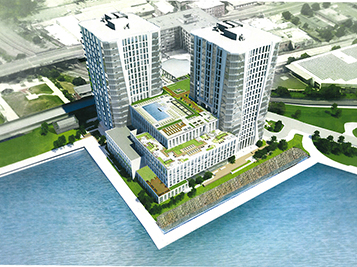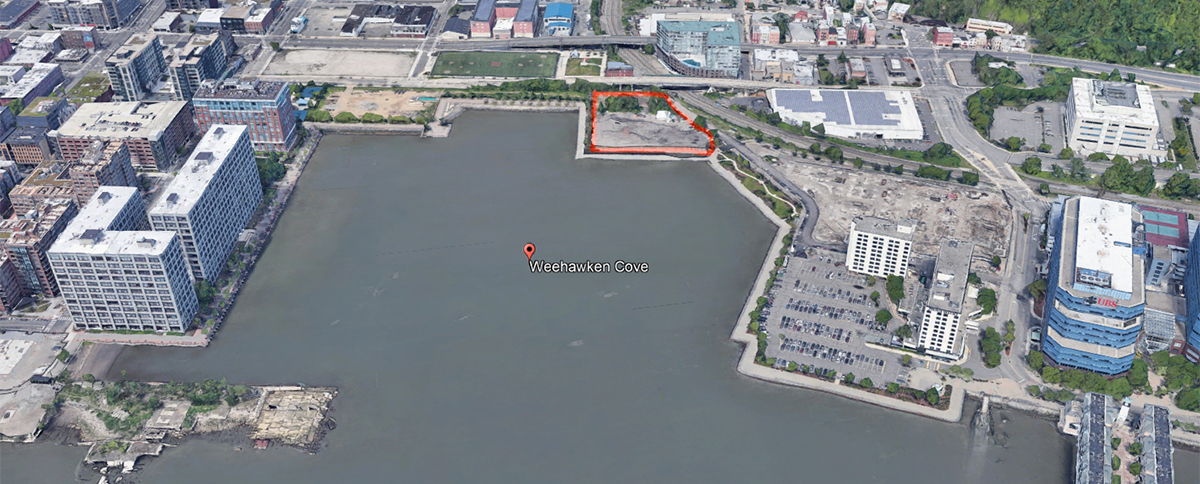For the past several months, Hartz Mountain has been driving piles for a pair of high-rise towers at the Weehawken Cove, just north of the Hoboken border. This work is proceeding despite the fact that the ordinance pertaining to this project and the Weehawken Planning Board approvals are being challenged in New Jersey Superior Court.
This past December, Superior Court Judge Joseph A. Turula held a case management conference consolidating the cases of three plaintiffs, including the Fund for a Better Waterfront (FBW), challenging this project. The suits were filed more than a year earlier in August of 2020. FBW is represented by land-use attorney Gerald Muller of Princeton, New Jersey.
At the case management conference, it was agreed that the challenge to the ordinance would be heard first. If the plaintiffs prevail on this issue, the Board approval would then be considered null and void. Judge Turula will also determine the scope of discovery that will be allowed, as the plaintiffs are seeking to determine the circumstances surrounding the zoning change to accommodate Hartz’s development application.
Throughout several years of hearings before the Weehawken Planning Board, residents of Weehawken, Union City and Hoboken showed up to speak out in opposition to this project. The Planning Board rejected Hartz’s initial proposal for this site that called for 334 residential units in two 200-foot towers atop a seven story parking garage.
Subsequently, the Township of Weehawken amended its zoning ordinance, essentially to accommodate a scaled back project with 261 units and two 160-foot towers. After several months of hearings in 2020, the Weehawken Planning Board granted approval for the project.
In August 2020, plaintiffs filed complaint with the Court asserting the following:
If built, the towers would abut a four-acre public park that is being built by the Rebuild by Design project on the Hoboken side of the Weehawken Cove. The Atir building would sit a mere 30 feet from the river, separated by the state-mandated waterfront walkway.
At one of the final planning board hearings, Maryann Bucci-Carter, an urban planner, testified before the Weehawken Planning Board on behalf of the objectors. She explained that the latest thinking on urban redevelopment is “based on principles of how cities and towns developed in the last century, which is how Weehawken developed.” She explained that in the older Weehawken neighborhood atop the Palisades the layout of the streets is traditional. “They’re walkable blocks and streets. The housing and shopping is in close proximity. There’s accessible public spaces . . . the buildings are focused on human-scale planning and design.”
In her testimony, Ms. Bucci-Carter pinpointed the essential problem with the Atir project: its failure to create a real neighborhood. She also pointed to a planned development in Jersey City, Liberty Harbor North, that has been made successful by first laying out a traditional-style street grid. Facing the street are a mix of residential and retail uses. Walking down the blocks, one sees stoops, front doors and windows. Parking garages at the interior of the blocks are concealed behind the residential and retail uses.
Related links
FBW appeals approvals for high-rise development at Weehawken Cove
Latest Lincoln Harbor project disregards good planning principles
Liberty Harbor North Redevelopment Plan
Multiple lawsuits challenge new ordinance for Lincoln Harbor
Planning Board votes down high-rise towers at Weehawken Cove after persistent opposition
Objectors mobilize against massive towers proposed at Weehawken Cove
Col. Stevens vision for Hoboken still valid 200 years later
Hoboken’s first parks established in 1804



